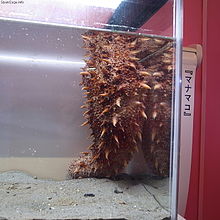Apostichopus japonicus
| Apostichopus japonicus | |
|---|---|
 |
|
| Scientific classification | |
| Kingdom: | Animalia |
| Phylum: | Echinodermata |
| Class: | Holothuroidea |
| Order: | Aspidochirotida |
| Family: | Stichopodidae |
| Genus: | Apostichopus |
| Species: | A. japonicus |
| Binomial name | |
|
Apostichopus japonicus (Selenka, 1867) |
|
| Synonyms | |
|
|
Apostichopus japonicus is a species of sea cucumber in the family Stichopodidae. It is found in shallow temperate waters along the coasts of south east Asia and is commonly known as the Japanese spiky sea cucumber or the Japanese sea cucumber.
The Japanese sea cucumber has a cylindrical leathery body with blunt, thorny protuberances. At the anterior or front end there is a mouth surrounded by a ring of short feeding tentacles and at the posterior end is the anus. There are three different colour morphs, red, green and black.
The Japanese sea cucumber is found along the coast of Russia, China, Japan and Korea. The range extends from Alaska and Sakhalin Island to the Amami Islands, Japan. The red morphs are found on gravel beds offshore at depths of 40 metres (130 ft) or deeper while the other two colours are found intermingled on muddy and sandy bottoms at shallower depths. Although the red morph may breed red offspring due to its reproductive isolation in a different microhabitat, DNA studies have shown that there is a limited degree of genetic difference between it and the other two colour morphs while there is no significant difference between the black and green forms. In lagoons in southern Sakhalin, Russia, Japanese spiky sea cucumber are found on solid substrates among growth of the red alga Ahnfeltia tobuchiensis and in oyster beds (Crassostrea gigas).
The Japanese sea cucumber sifts through the sediment on the seabed with its tentacles and feeds on detritus and other organic matter including plant and animal remains, bacteria, protozoa, diatoms and faeces.
The sexes are separate in the Japanese sea cucumber. Males and females release a mass of gametes into the sea where fertilization takes place. In the laboratory, spawning from ripe gonads can be induced by varying the temperature at which the adults are kept or by use of the neuropeptide cubifrin. The planktonic larvae develop through several stages before settling on hard surfaces on the seabed, undergoing metamorphosis and becoming juveniles.
...
Wikipedia
